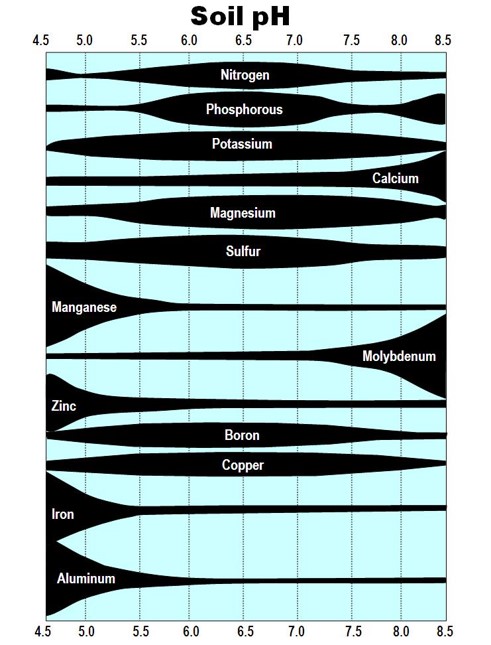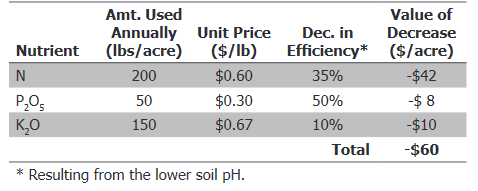Fertilization can be a significant portion of the cost of producing forages. According to UGA production budgets, fertilization can range from 30 to 60% of the total variable cost of producing various forages. So, taking a little time to strategically plan your fertilization program can hopefully save you money in the end. Steps that you can take include soil sampling, application timing, and rate.
Take a soil sample…. One of the basic steps in determining a fertilization program is taking a soil sample. Soil samples give producers a strategy on applying enough fertilizer and or lime to maximize yields. Soil pH is a key factor to maintain root development and nutrient availability.

The table above illustrates the relationship between soil pH and the availability of plant nutrients in soils. For example, if soil pH drops below 6.0, nitrogen, phosphorus, and potash become less available. A wider bar in the table indicates an increased availability of the nutrient. If the soil pH drops below 5.4 then aluminum and manganese can be toxic to some crops. On the other hand, nutrients such as iron, manganese, zinc, and others become less available if the pH is too high. If soil pH needs to be adjusted higher then it is advised to apply the lime a few months ahead of planting.

This table represents a comparison of the annual value of decreased fertilizer efficiency in a soil where the pH is 5.6 relative to a soil with a pH of 6.2. It contains the amount of nutrients used annually in a forage crop and the percent of decreased efficiency of N-Nitrogen, P-Phosphorus, and K-Potassium. Can low soil pH cost a producer money? Yes! In this example, the 5.6 pH costs the grower about $60 per acre.
Soil test recommendations…. County Extension agents get questions all the time about soil sample results. A question that I receive from forage growers from time to time is “Will this fertilizer application make me any money?” According to the UGA Soil Test Handbook, the pounds per acre of phosphorus and potassium extracted from the soil are index values. They do not represent the actual amount of phosphorus and potash that is available to the plant. Soil sample results will place the index levels in low, medium, high, and very high categories. A low level means that a yield response would be expected 80% of the time from a phosphorus or potash application. A medium-level would indicate a 50% probability of yield response from an application. A high level would indicate a low probability of a yield response usually less than 10% of the time.
Fertilizer application timing…. When your soil sample comes back, it gives information about how much and when to apply fertilizer during the growing season based on the crop you are growing. The timing of fertilizer applications can influence yield. For example, hybrid bermudagrass can utilize 200 to 400 lbs of nitrogen per year based on yield goals. Growers need to split the nitrogen during the production year. A good strategy would be applying 75 to 100 lbs of nitrogen per acre when spring growth begins and 75 to 100 lbs after each harvest. If you assume 4 harvests, 200 lbs of nitrogen per acre should produce 4 to 5 tons of hay per acre. If you increase to 400 lbs of nitrogen per acre a yield goal of 7 to 8 tons is reasonable. This would depend on the yield environment.
Growers might consider splitting the potash applications on bermudagrass. Consider one half in the spring and the other half of the recommendation after the second or third cutting. This would reduce the change of winter injury, increase disease resistance, and might improve the stand. All the phosphate can be applied in the spring or at the time the potash is applied.
If you have questions about soil sampling, forage production, or other topics in agriculture please contact your local county Extension agent.